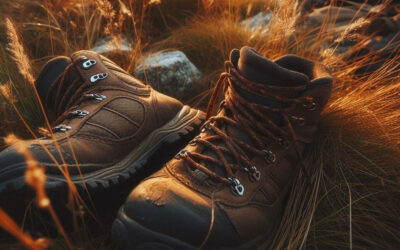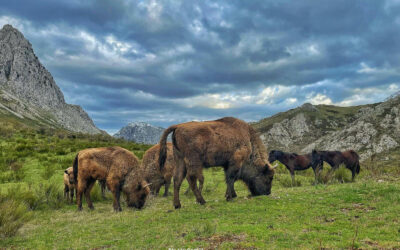Photo credit: Photo by Ravi Kumar on Unsplash.
Trusting Tech and Wilderness in the 21st Century: A Response to Keeling’s The Trouble with Virtual Wilderness
BY KEELY FISHER
Stewardship
October 2024 | Volume 30, Number 2

I would like to thank Paul Keeling for taking the time to thoughtfully engage with my argument. I appreciate his perspectives and understand why he, as well as others, may have reservations about virtual reality (VR) wilderness. Keeling himself goes so far as to characterize VR wilderness as repulsive, taking the possibilities of VR wilderness to an extreme and painting the technology as a pervasive and dangerous threat to the existence of real wilderness. This position overamplifies the negative possibilities of VR wilderness while not addressing the continued ramifications of limiting our understanding about what wilderness is and what it can be. What I hope to do in this response is address some of his concerns about my stance on the relationship between VR wilderness and real wilderness. What I understand, however, is that an argument about the merits of VR wilderness can be an uncomfortable one. Hesitation about VR wilderness – or any new technology – is not an irrational or invalid stance. Technology has and will continue to have an impact on the way that we engage with the natural world, and I am not naive about the ways that people use technology to radically reshape our wilderness. This is not something I am worried about with VR, as I continue to argue that VR wilderness acts as a supplement to experiences in the natural world. I hope that by the end of this response, it is better understood that what I am continuing to advocate for is not a replacement of real wilderness or a comparison between VR wilderness and real wilderness. Rather, I argue that VR wilderness acts as a documentation of the natural world, necessitates the existence of real wilderness, does not threaten the existence of real wilderness, and – importantly – can increase the accessibility of wilderness experiences. For these reasons, the merits of VR as a tool to democratize wilderness experiences and promote connection to the natural world far outweigh any supposed risks posed by the new technology.
Documentation of the Natural World
When I originally said that VR grants us access to wilderness as well as the ideals and emotions that we associate with it, I did not think that it was a controversial statement. Throughout history, many people have used different forms of media – paintings, photographs, nature documentaries – to convey replicas of wilderness to those who were unable to visit the real thing. I would argue that people who use these replicas to experience wilderness have, in some ways, been connected to wilderness and had access to it, although they had not experienced real wilderness in person. Keeling disagrees with this characterization, asking, “How can it [VR wilderness] connect people to real wilderness?” (Keeling 2024, p. 11). He then posits that, perhaps, VR allows for us to connect with wilderness in two ways: by inspiring people to visit a real wilderness area or, as I have argued, by evoking powerful, important emotions that we often connect to experiences in real wilderness. Keeling would suggest the latter does not constitute a connection or access to real wilderness. I believe we might largely agree about what is happening when people experience VR wilderness and may simply be arguing about the words we should use to label this phenomenon. However, there is one element of our respective understandings of the experience of VR wilderness that differs and may be leading to our disagreement over appropriate characterizations of this phenomenon.
Keeling uses an analogy that VR is something akin to talking to a simulation of your loved one instead of talking to them in real life, but this does not at all reflect the relationship between VR wilderness and real wilderness. In this analogy and in other places throughout his response, Keeling seems to suggest that VR simulates or creates fake wilderness from scratch when what VR does in actuality is take high-resolution panoramic images of wilderness in order to present them to viewers in a more engaging and interactive way than traditional media. Keeling’s (2024) repeated use of the words “simulation” and “fabrication” as well as his description of VR as “wholly the product of human purpose, intention and design” (p.13) make it seem as if he is conceiving of VR more like a first-person video game where the player explores an entirely virtual three-dimensional model based on a real place.
I would argue that there is an important philosophical distinction to be made between simulating and documenting, and VR wilderness falls on the side of documenting wilderness. As a documentation, VR wilderness is in the same category as, for example, a recording of a song, which no one would call a simulation or fabrication or entirely the product of the recorder. Contrary to Keeling’s analogy, VR is much more like having a video call with your loved one instead of meeting them in person. It may not be exactly the same (we can recognize it is nice to see your loved ones in person), but as we all learned during the recent COVID-19 pandemic, a video call with your loved one can be incredibly meaningful, especially when you cannot see them in person. Likewise, VR wilderness experiences can be incredibly meaningful and important for those who are not able to access real wilderness spaces in person.
Compared to other media depicting wilderness, such as the Planet Earth documentary series Keeling references, VR is a much more objective documentation of wilderness because it offers multiple perspectives for the user to explore rather than only the perspective and narrative created by a filmmaker, photographer, or artist. Nonetheless, even the most faithful documentation of wilderness reflects the perspective and purposes of its creator, and Keeling may see this as representing “the objective difference in meaning and value between VR wilderness and actual wilderness, namely, their different causal genesis and relation to human purpose” (Keeling 2024, p. 13). This distinction relies on the idea that, unlike VR, real wilderness experiences are not the product of or modulated by human purpose, but this is not true. From the creation of national parks to the Wilderness Act of 1964 to the ways that we manage land for invasive species, we have always held wilderness to a standard of meeting human purpose, and our experiences of wilderness have been largely shaped by human purposes. VR may be more easily traced to its human designers, but that does not mean that real wilderness can be extricated from human intent. Although Keeling points to this supposed distinction as a reason that “VR wilderness can fulfill its purpose without actual wilderness existing at all” (Keeling 2024, p. 13), there are several reasons that VR wilderness necessitates the existence of real wilderness.
Necessity of Real Wilderness
When people use VR wilderness, many of them are using it purposefully to access a place in the real world that they cannot otherwise go to or, for whatever reason, would not otherwise experience. The people who are using VR wilderness are not just “scoring points” or moving through the story as one does in a video game; they are using it to see specific places such as the Grand Canyon or the summit of Mt. Everest that have barriers to visiting in person. The value of these experiences lies in their connection to real, meaningful places in our world, and simulations created by artists’ imaginations or even generative AI in digital, video-game style models cannot have the same impact.
Certainly, the counterargument can be made that once a piece of wilderness has been documented for the VR version, the real place could then be hypothetically destroyed without decreasing the value of the VR experience. Such a situation could arguably increase the value of a documented VR wilderness if there were no alternative. However, the aforementioned purpose and the rate at which technology continues to evolve would imply that VR wilderness (and other digital technologies) will continue to rely on the existence of real wilderness. For example, many of us know the difference between a movie from 2001 and 2021 because the technology has evolved so rapidly. Likewise, VR has continued to evolve, with new assistive technologies coming out as recently as January 2024 (see, for example, an omnidirectional VR walking pad from Disney [Diaz 2024]). To keep up with technological demands, we will have to reference real wilderness and continually go out and redocument wilderness spaces. This cannot be done if they do not exist.
Not a Replacement for Real Wilderness
VR wilderness’s reliance on real wilderness is important because it relates to one of Keeling’s primary concerns: if people see VR wilderness as an acceptable substitute to real wilderness, then there will be no reason why we cannot bulldoze wilderness areas for commercial use and instead use VR. I take the threat of such a line of thinking seriously, as wilderness areas face constant pressure from climate change, corporate greed, and urban sprawl, so their preservation relies on a society that recognizes their irreplaceability and value. For two main reasons, however, the threat of VR wilderness replacing real wilderness is not likely enough to warrant such vehement pushback against the existence and progress of VR wilderness.
First, there is enough of a difference between VR and real wilderness that the substitution of VR wilderness experiences for real wilderness experiences would not be accepted by society. This argument is not based on the technological limitations of today’s VR, as we will certainly see the technology improve – perhaps even to the perfect, indistinguishable wilderness experience machine that Keeling hypothesizes (2024). Keeling’s explanation of a person feeling “short-changed” by such a machine used deceptively and in place of real wilderness rings true for many people. There is also merit to Kahn’s idea of “environmental generational amnesia,” which Keeling cites as a mechanism by which these attitudes toward VR wilderness could evolve (Keeling 2024). However, this phenomenon makes more sense for the original context of wilderness degrading in quality and availability than for its complete replacement with VR technology. Although people may set a baseline for what they understand and expect wilderness to be based on their experiences and the environment, I do not believe that expectations of or desires for real versus VR wilderness are set in the same way. In fact, I would contend that people’s objections to VR wilderness are a widespread instinct based more on innate human desire for “real” over “fake” than in education or lived experiences. No amount of generational amnesia is or will ever be likely to change the fact that most people will see the difference between real wilderness and VR wilderness as significant.
It is unlikely that VR wilderness will ever be seen as a perfectly suitable replacement for real wilderness, but even if they were to be seen as equivalent, the existence and acceptance of VR wilderness would not necessarily justify the elimination of wilderness areas. As Keeling argues, the value of wilderness extends beyond the subjective human experience of it, which is the only aspect that VR wilderness could seek to replace. He references Elliott’s argument that some part of the value comes from its “non-human genesis” (Keeling 2024, p. 3). I would go even further and say that wilderness has a long list of values beyond our subjective enjoyment of it. These include, for example, habitat preservation, biodiversity and existence values, and air, water, and soil quality. You cannot simulate clean air, endangered species cannot live on a computer, and you cannot encode the true value of wilderness into a VR experience, no matter how compelling. This is more than reason enough to preserve wilderness, even if people feel that VR wilderness might replicate the human experience and enjoyment of natural spaces. If we want to protect wilderness and natural spaces long into the future, we need to ensure that enough people recognize these values. VR wilderness has the potential to be a powerful means of educating and inspiring future generations to ensure these values and our wilderness spaces are not lost.
Accessibility to Wilderness Experiences
One of the values of VR wilderness – arguably one of its most important values – is this technology’s ability to democratize access to remote and otherwise inaccessible wilderness. This is especially important as access to natural and wilderness spaces has become even more restrictive. Access to remote wilderness spaces has never been easy or equal for the masses; historically, national parks have been used to bridge the gap between wilderness and the American public.
It is well-known that visitation to national parks in the United States continues to increase (Flowers 2016; US National Park Service 2024). Although this visitation is incredibly important, it comes with some problems, chief among them overcrowding in parks (US Department of the Interior 2022). During peak times in Yosemite and the Grand Canyon, visitors can expect to wait upward of two hours to even enter the park (Larson 2023; Spencer 2023; US National Park Service 2024). To combat the crowds, many national parks, including Acadia, Arches, Rocky Mountain, Yosemite, and Zion, are now requiring reservations to access either some or all parts of the park (Baran 2023; Fox 2023). Many worry about the effects of such systems, with Rice and others (2022) conducting an exploratory study that found these reservation systems often exclude low-income and possibly nonwhite populations at higher rates than campsites without reservation systems. For some populations, it is certainly possible to jump through the hoops necessary to visit these places or to visit other natural places that are less crowded, but one of the primary purposes of the national parks is to be accessible to the masses. As they become less and less accessible, we must think about alternatives that can be a low barrier-to-entry option. By allowing people who do not have the physical, financial, or temporal ability to access these spaces, VR can be one of our greatest tools for showing the beauty and intrinsic value of wilderness. Therefore, far from providing an alternative that will stop people from recognizing the need for real wilderness, I believe that VR wilderness has the potential to increase the number of people who see the value of wilderness and its continued existence.
Change has never been comfortable, and it is important to recognize that VR may change how many people choose to engage with the natural world. However, it is also important to recognize that VR does not and cannot act as a replacement for real wilderness. Instead, the existence of VR wilderness both necessitates and strengthens the existence of real wilderness. Accessibility has always been a fundamental aspect of my argument for the recognition of VR wilderness as a valid way of engaging in wilderness experiences and, by extension, as a valid way of learning to care for wilderness spaces. Martin Edström, a National Geographic Explorer and photojournalist who seeks to encourage preservation by connecting his audience to nature, summed up one of the major benefits of VR quite nicely: ‘“If you want someone to care for something, you first have to make them feel it,’ he says. ‘That’s why working with these immersive techniques is so powerful have this new tool at my disposal to bring people into the story”’ (Langenheim 2021). For some, VR wilderness will never be acceptable. For others, however, this technology provides an important access point to an otherwise inaccessible place that allows for more people to experience and, by extension, care for the grandeur and intrinsic value associated with our world’s wildernesses.
KEELY A. FISHER is a PhD student at the Ohio State University; email: fisher.2082@buckeyemail.osu.edu.
References
Baran, M. These 8 U.S. national parks now require reservations. AFAR. December 27, 2023. https://www.afar.com/magazine/these-national-parks-require-reservations-for-summer-2021.
Diaz, M. Disney made a multi-user treadmill that lets you walk around in VR – here’s how it works. ZDNet. January 24, 2024. https://www.zdnet.com/article/disney-made-a-multi-user-treadmill- that-lets-you-walk-around-in-vr-heres-how-it-works/.
Flowers, A. The national parks have never been more popular. FiveThirtyEight. May 25, 2016. https:// fivethirtyeight.com/features/the-national-parks-have-never-been-more-popular/.
Fox, A. These national parks will require reservations in 2024. Travel + Leisure. December 31, 2023. https://www.travelandleisure.com/national-parks-2024-entry-reservations-8403409.
Keeling, P. 2024. The trouble with virtual wilderness. The International Journal of Wilderness 30(1): 10–14.
Langenheim, J. Being there: How technology can bring us closer to nature – and help protect it. National Geographic. November 17, 2021. https://www.nationalgeographic.com/environment/article/paid-content-how-technology-can-help-protect-our-nature.
Larson, A. Yosemite National Park visitors face unprecedented wait times. Kron4. July 3, 2023. https://www.kronon.tv/embed/player.
Rice, W. L., J. R. Rushing, J. M. Thomsen, and P. Whitney. 2022. Exclusionary effects of campsite allocation through reservations in U.S. national parks: Evidence from mobile device location data. Journal of Park and Recreation Administration 40(4): 45–65. https://doi.org/10.18666/jpra- 2022-11392.
Spencer, C. Visiting Yosemite? Be prepared to wait in line for hours. Los Angeles Times. June 30, 2023. https://www.latimes.com/california/story/2023-06-30/yosemite-national-park-crowds-traffic-no-reservations-summer.
US Department of the Interior. Overcrowding in parks. December 13, 2022. https://www.doi.gov/ocl/ overcrowding-parks
US National Park Service. Visiting Grand Canyon during spring break 2024. NPS Grand Canyon. N.d. Retrieved March 18, 2024, from https://www.nps.gov/grca/planyourvisit/sr-tips.htm.
US National Park Service. Hidden gems, off-season trips highlights of 325.5 million national park visits in 2023. National Park Service. February 22, 2024. https://www.nps.gov/orgs/1207/hidden- gems-off-season-trips-highlights-of-325-5-million-national-park-visits-in-2023.htm.
Read Next
Missing the Forest for the Algorithm
What is the value of wilderness? Well, what you have just completed reading is the “value of wilderness” as described by ChatGPT 3.5.
Rewilding Prerequisites: An Ecocentric Approach
Rewilding is increasingly gaining momentum as a conservation practice in Europe.
Benefits and Trade-Offs of Environmental DNA (eDNA) in Wilderness Character Monitoring
Visitor Perspectives on Removing and Maintaining Dams in Wilderness



